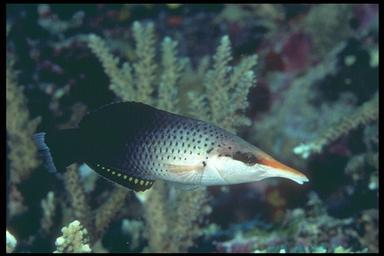Bird Wrasse

You can easily recognize the bird wrasse (Gomphosus varius) because it has an elongated beak. It belongs to the family Labridae.
Bird wrasses can be easily sexed because males are much more colorful. Males are green with a small amount of blue and females are brownish in color. Both males and females are brownish in color as juveniles, and males take on their green color as they mature. The bird wrasse in the photo on this page is a female.
In fact, the color of the male and female is so different that sometimes the male bird wrasse is called a "green bird wrasse" and the female is often called a "brown bird wrasse."
As juveniles, both sexes lack the elongated beak. As they mature the beak elongates.
Bird wrasses need a spacious aquarium. They reach an adult size of about 11-12 inches (28-30 cm) in length and you must provide them with enough swimming room. They are active fish.
In addition, they don't make good reef fish - they often eat the invertebrates. Bird wrasses will also eat smaller fish so choose their tank companions carefully.
In addition, don't keep two males in the same aquarium or trouble will start. If you keep a male-female pair, put the female in the tank first and let her get settled in, then add the male to the tank.
You should provide plenty of live rock and caves for hiding places in their aquarium. The bird wrasse is active during the daytime and hides in caves at night.
In their natural environment, in the Indo-Pacific, they feed on reef invertebrates and on small fish. In captivity they can be fed mysis shrimp, vitamin-enriched brine shrimp, and frozen food for marine carnivores.
The bird wrasse can usually be purchased for about $35-70 depending on the size, sex, and location that it is obtained from.
